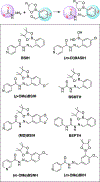Modifying aroylhydrazone prochelators for hydrolytic stability and improved cytoprotection against oxidative stress
- PMID: 30429096
- PMCID: PMC6314015
- DOI: 10.1016/j.bmc.2018.11.004
Modifying aroylhydrazone prochelators for hydrolytic stability and improved cytoprotection against oxidative stress
Abstract
BSIH ((E)-N'-(2-(4,4,5,5-tetramethyl-1,3,2-dioxaborolan-2-yl)benzylidene)isonicotinohydrazide) is a prodrug version of the metal chelator SIH ((E)-N'-(2-hydroxybenzylidene)isonicotinohydrazide) in which a boronate group prevents metal chelation until reaction with hydrogen peroxide releases SIH, which is then available for sequestering iron(III) and inhibiting iron-catalyzed oxidative damage. While BSIH has shown promise for conditionally targeting iron sequestration in cells under oxidative stress, the yield of SIH is limited by the fact that BSIH exists in cell culture media as an equilibrium mixture with its hydrolysis products isoniazid and 2-formylphenyl boronic acid. In the current study, several BSIH analogs were evaluated for their hydrolytic stability, reaction outcomes with H2O2, and prochelator-to-chelator conversion efficiency. Notably, the para-methoxy derivative (p-OMe)BSIH ((E)-N'-(5-methoxy-2-(4,4,5,5-tetramethyl-1,3,2-dioxaborolan-2-yl)benzylidene)isonicotinohydrazide) and the meta-, para-double substituted (MD)BSIH ((E)-N'-((6-(4,4,5,5-tetramethyl-1,3,2-dioxaborolan-2-yl)benzo[d][1,3]dioxol-5-yl)methylene)isonicotinohydrazide) showed 1.3- and 1.9-fold improved hydrolytic stability compared to BSIH, respectively, leading to a 22 and 50% increase in chelator released. Moreover, both prochelators were found to protect retinal pigment epithelial cells stressed with either H2O2 or paraquat insult.
Keywords: Chelating agent; Cytoprotection; Fenton chemistry; Iron; Oxidative stress.
Copyright © 2018 Elsevier Ltd. All rights reserved.
Figures










Similar articles
-
The hydrolytic susceptibility of prochelator BSIH in aqueous solutions.Bioorg Med Chem Lett. 2017 Sep 1;27(17):4165-4170. doi: 10.1016/j.bmcl.2017.07.019. Epub 2017 Jul 8. Bioorg Med Chem Lett. 2017. PMID: 28734582 Free PMC article.
-
Iron prochelator BSIH protects retinal pigment epithelial cells against cell death induced by hydrogen peroxide.J Inorg Biochem. 2008 Dec;102(12):2130-5. doi: 10.1016/j.jinorgbio.2008.08.001. Epub 2008 Aug 24. J Inorg Biochem. 2008. PMID: 18835041 Free PMC article.
-
Comparison of various iron chelators and prochelators as protective agents against cardiomyocyte oxidative injury.Free Radic Biol Med. 2014 Sep;74:210-21. doi: 10.1016/j.freeradbiomed.2014.06.019. Epub 2014 Jun 30. Free Radic Biol Med. 2014. PMID: 24992833 Free PMC article.
-
Characterization of cytoprotective and toxic properties of iron chelator SIH, prochelator BSIH and their degradation products.Toxicology. 2016 Mar 28;350-352:15-24. doi: 10.1016/j.tox.2016.03.004. Epub 2016 Apr 1. Toxicology. 2016. PMID: 27046792 Free PMC article.
-
Prochelator strategies for site-selective activation of metal chelators.J Inorg Biochem. 2016 Sep;162:31-43. doi: 10.1016/j.jinorgbio.2016.05.012. Epub 2016 May 17. J Inorg Biochem. 2016. PMID: 27297691 Review.
Cited by
-
Design of Tetrazolium Cations for the Release of Antiproliferative Formazan Chelators in Mammalian Cells.J Am Chem Soc. 2023 Jul 19;145(28):15197-15206. doi: 10.1021/jacs.3c02033. Epub 2023 Jul 6. J Am Chem Soc. 2023. PMID: 37410992 Free PMC article.
-
Boronate-Based Bioactive Compounds Activated by Peroxynitrite and Hydrogen Peroxide.Redox Biochem Chem. 2024 Dec;10:100040. doi: 10.1016/j.rbc.2024.100040. Epub 2024 Aug 14. Redox Biochem Chem. 2024. PMID: 39678628
-
Prodrug strategies for targeted therapy triggered by reactive oxygen species.Medchemcomm. 2019 May 8;10(9):1531-1549. doi: 10.1039/c9md00169g. eCollection 2019 Sep 1. Medchemcomm. 2019. PMID: 31673314 Free PMC article. Review.
References
-
- Stockwell BR; Friedmann Angeli JP; Bayir H; Bush AI; Conrad M; Dixon SJ; Fulda S; Gascón S; Hatzios SK; Kagan VE; Noel K; Jiang X; Linkermann A; Murphy ME; Overholtzer M; Oyagi A; Pagnussat GC; Park J; Ran Q; Rosenfeld CS; Salnikow K; Tang D; Torti FM; Torti SV; Toyokuni S; Woerpel KA; Zhang DD. Ferroptosis: A Regulated Cell Death Nexus Linking Metabolism, Redox Biology, and Disease. Cell 2017; 171: 273–285. - PMC - PubMed
-
- Zecca L; Youdim MB; Riederer P; Connor JR; Crichton RR. Iron, brain ageing and neurodegenerative disorders. Nat. Rev. Neurosci 2004; 5: 863–873. - PubMed
-
- Zhou T; Ma Y; Kong X; Hider RC. Design of iron chelators with therapeutic application. Dalton Trans 2012; 41: 6371–6389 - PubMed
-
- Dunaief JL. Iron induced oxidative damage as a potential factor in age-related macular degeneration: The Cogan Lecture. Invest. Ophthalmol. Vis. Sci 2006; 47: 4660–4664. - PubMed
Publication types
MeSH terms
Substances
Grants and funding
LinkOut - more resources
Full Text Sources
Research Materials

